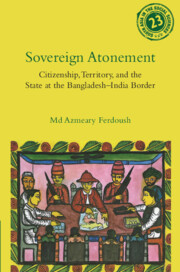Book contents
- Frontmatter
- Contents
- List of figures
- Preface
- Acknowledgments
- Introduction: Remnants, nations, and the sovereign
- 1 Sovereign atonement
- 2 From “sensitive” to “symbolic” spaces
- 3 Land and citizenship as technologies of territory
- 4 Everyday governance: Ambiguity, accountability, and abundance
- 5 Infrastructure, belonging, and the state
- 6 Refusal and tolerance
- Epilogue
- Appendix: A note on methods
- References
- Index
2 - From “sensitive” to “symbolic” spaces
Published online by Cambridge University Press: 30 April 2024
- Frontmatter
- Contents
- List of figures
- Preface
- Acknowledgments
- Introduction: Remnants, nations, and the sovereign
- 1 Sovereign atonement
- 2 From “sensitive” to “symbolic” spaces
- 3 Land and citizenship as technologies of territory
- 4 Everyday governance: Ambiguity, accountability, and abundance
- 5 Infrastructure, belonging, and the state
- 6 Refusal and tolerance
- Epilogue
- Appendix: A note on methods
- References
- Index
Summary
After a long rickshaw journey along zigzagging dirt paths, my research assistant, Morshed, and I finally arrived at one of the former Indian enclaves in Bangladesh. To be sure, I asked a man in a small shop selling cigarettes, “Is this the enclave of Kotvajni?” Unable to mask his irritation, he replied, “No, this is the former enclave of Kotvajni. This is now Bangladesh.” He placed extra emphasis on the word ‘former’ when he answered. With a smile on my face and a small nod of my head, I said, “Thank you,” feeling a little ashamed of my inauspicious arrival in the former enclave. Yet I was also excited to learn about this new chapter in the lives of the residents who had finally achieved the exchange of the border enclaves after almost seventy years of uncertainty and de facto statelessness.
Even during the many decades when they existed as enclaves, territorially surrounded by India or Bangladesh, they had no apparent marker to distinguish them from their surroundings. They had neither fences nor border guards to control or monitor the flow of people. People in the enclaves were not “different” by any measure from their neighbors beyond their status and lack of papers. Pillars or markers that were used to mark their boundaries either disappeared or remained hidden in the rice field. One needed prior knowledge of where exactly to look for or how to locate them. This made it even more difficult to distinguish the enclaves from their surroundings. Yet for almost seventy years, from 1947 until 2015, residents of enclaves like Kotvajni were not considered Bangladeshis, and these small pockets of land were not territories of Bangladesh. Officially at least, they had been Indian nationals living in Indian territories, effectively cut off from the mainland of India, and vice versa. These were essentially “stateless spaces” because they were not administered by the surrounding state, and the home state did not maintain any connection with them (Jones, 2009b; Shewly, 2013a).
Although these territories and their residents never received any care from their home states, they never lost significance in the territorial and nationalistic discourses of Bangladesh and India, which played a role in delaying the seemingly obvious solution of a territorial swap.
- Type
- Chapter
- Information
- Sovereign AtonementCitizenship, Territory, and the State at the Bangladesh-India Border, pp. 48 - 62Publisher: Cambridge University PressPrint publication year: 2024

